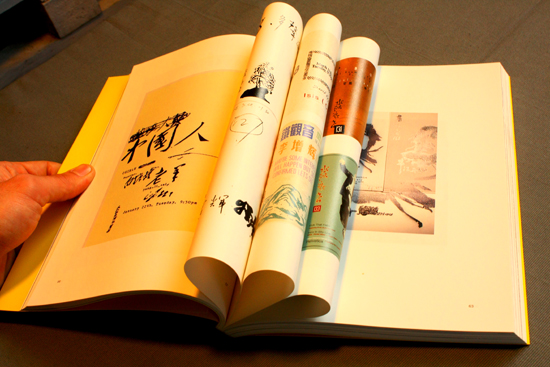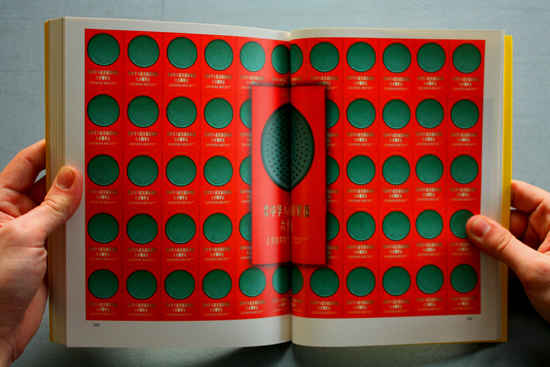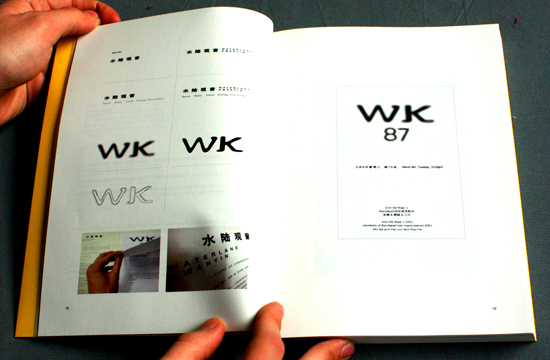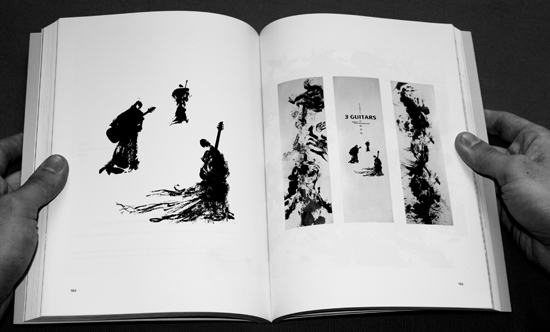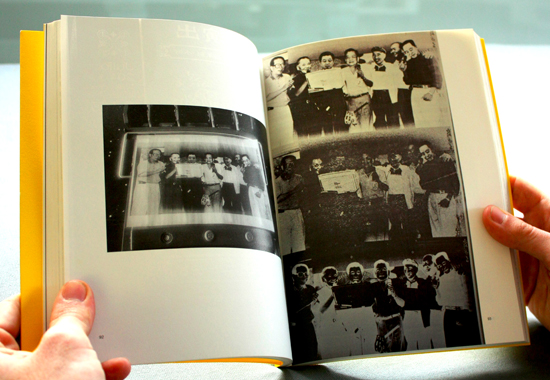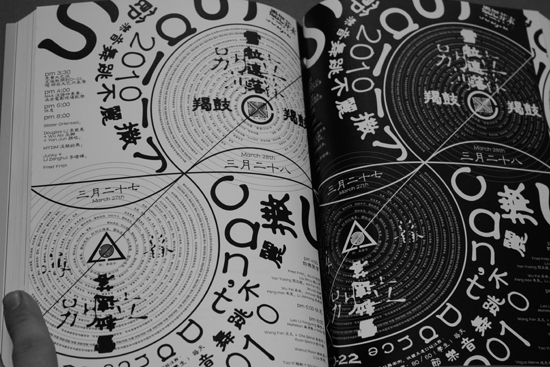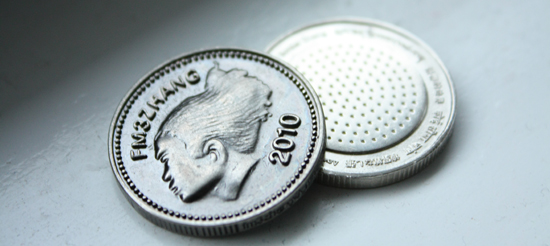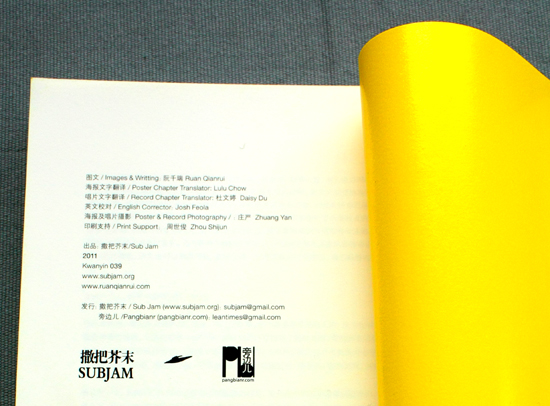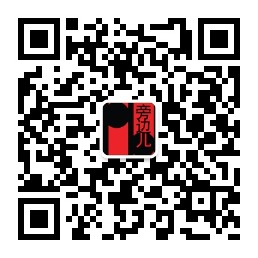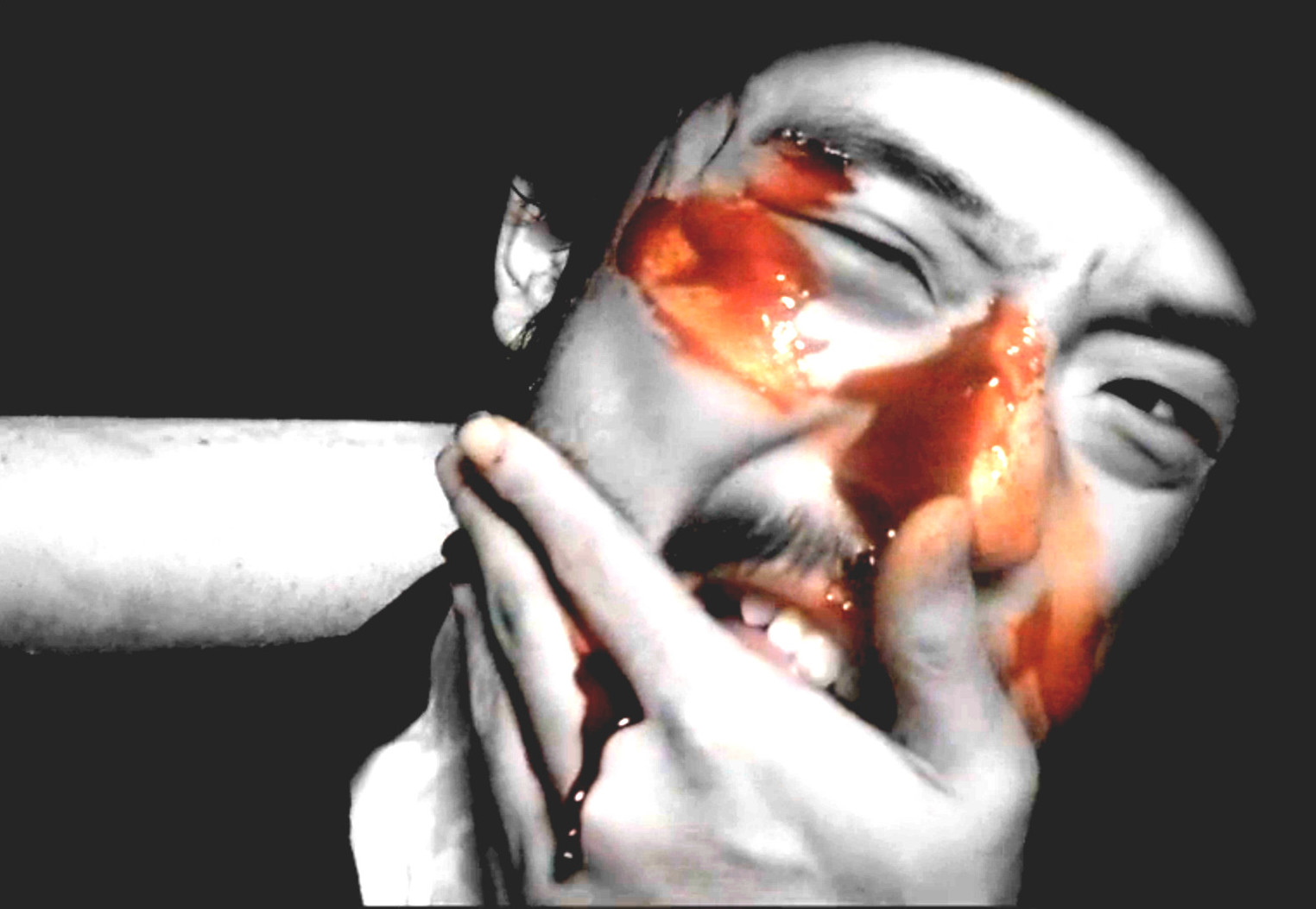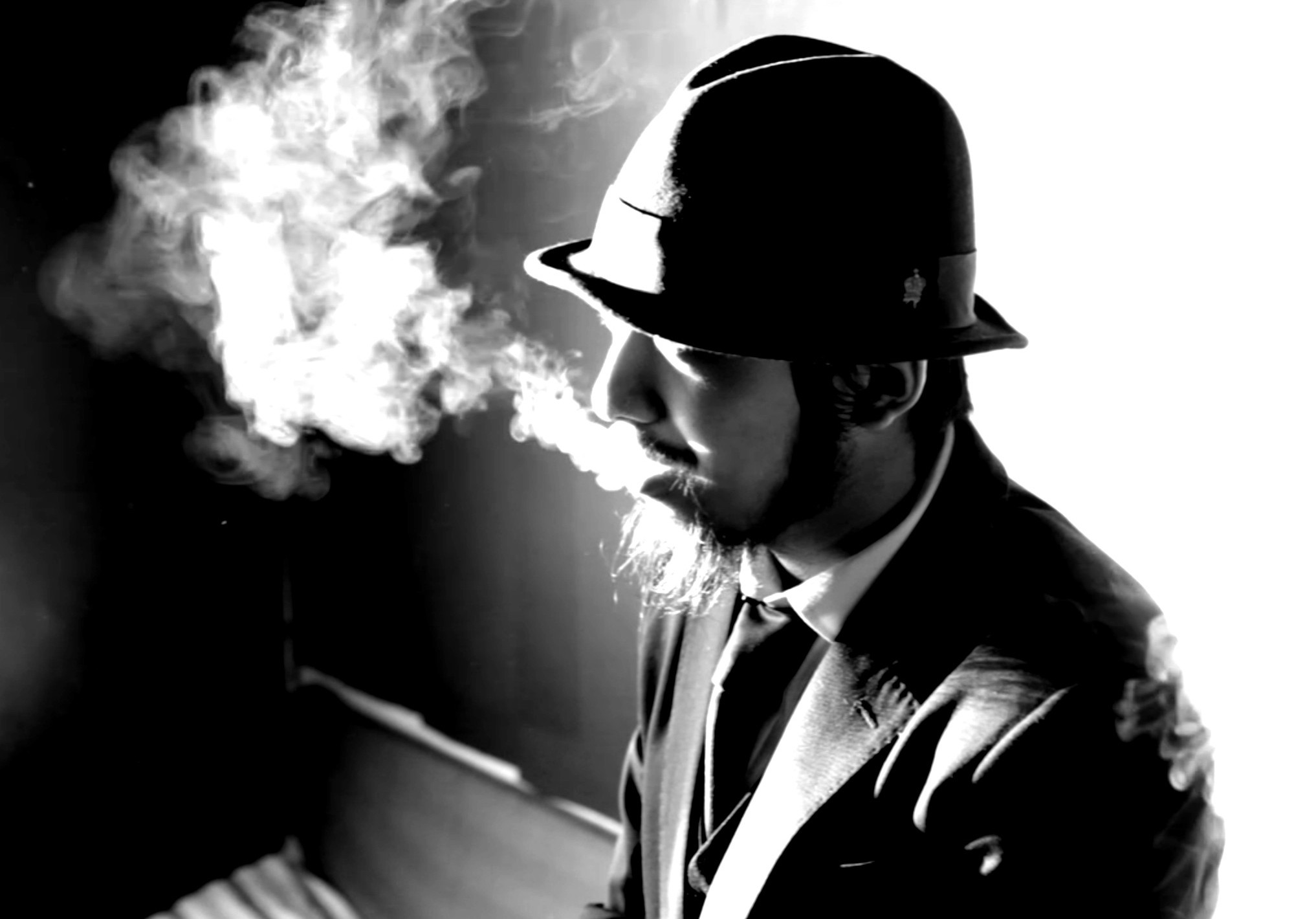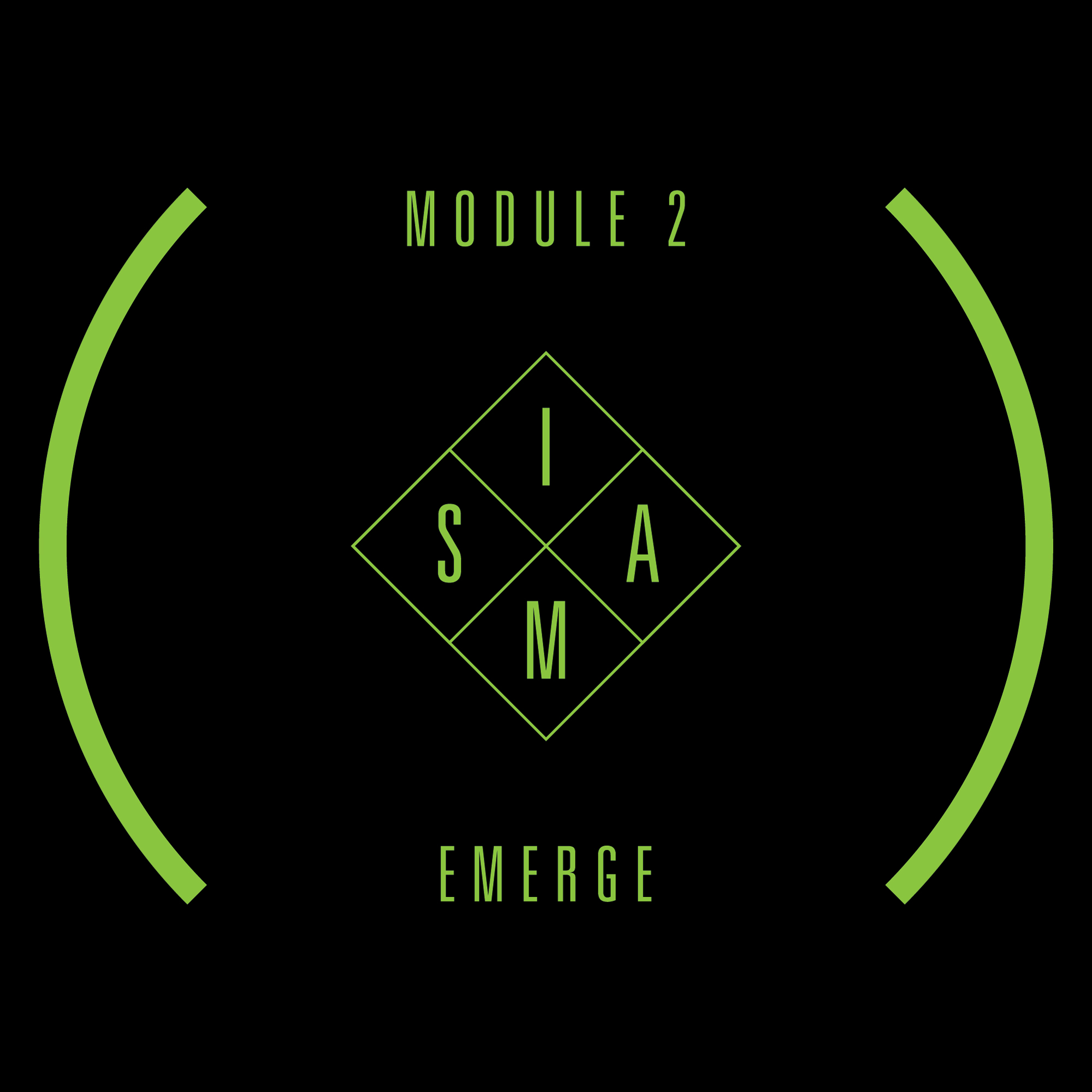阮千瑞和《毁烬蓝图》
Ruan Qianrui’s “Burned Blueprint”
By Josh, 2011年 2月 27日
《 English version 》
通过一段时间对撒把芥末设计师阮千瑞的唱片设计的关注,透过那些海报和唱片封面,我渴望能挖掘的更深。过去五年的经验使他已经能够独自对整个北京实验音乐文化做一个清晰的视觉化解读。2011年对他来说已经变得不再寻常以往:一月份他在伦敦V&A博物馆独立展出了自己的设计作品。现在他回到了北京,并已经做好准备在撒把芥末发行《毁烬蓝图》——2006至2010年的设计作品集。它既是一次个人设计经历的集结, 也是一次对北京地下实验文化的全程回顾。
我和阮千瑞聊起他做平面设计师的个人经历,尤其是和撒把芥末、观音唱片合作的这段长达五年半的时间,包括起初的作为无国界艺术家的想法。低调不是简单的目的或形式,在这个时代我们想它应被当做一种精神。我们尽量诚实地去思考,关注的也更多是精神,所以我们有幸能够采访阮千瑞。相信通过以下这个独家专访你可以了解到更多,包括他个人作品集的信息。(我们即将在旁边儿小卖部推出这本作品集,敬请期待!)
采访内容由Josh Feola提问,Lulu Chow编译 。
旁边儿: 你是哪一年来北京的?
阮千瑞: 01年,觉得这个城市跟艺术很近。和颜峻合作是在06年,水路观音开始。
旁边儿: 你曾经有过在学校或者进修班学习平面设计的经验吗?
阮: 没有,在北京找到工作之后是做广告,基本是到处蹭技术,恰好碰到一些好的人愿意传授内功,所以你可以称我为一个幸运儿。
旁边儿: 你是什么时候认识颜峻的?
阮: 在06年之前我就看过一些比较早的摇滚乐现场,五道口的“开心乐园”直接行动系列演出,direct Hit,太棒了! 从里面你可以听到很多无政府主义的思想,来自80年代那个时候的冲击,从西方过来的思想的冲击,安那其的想法,等等,那种年轻人可以改变世界的生猛,我自己对这个东西是有感情的。而且到了06年我自己从事商业设计的经验已经算是很多了,很熟练,在北京也可以生存下来,赢得了更多的业余时间去做我自己喜欢的事情,恰巧06年他也在做水陆观音,我也经常看他的网站,对他做的事情很感兴趣,也一直在关注。是偶然的一个想法.
撒把芥末,通过这个平台,我做演出海报,我在两年里,一下子接触到了各种各样的音乐人,一些能和我产生共鸣的,奇奇怪怪的人。
中间有一段时间我不在北京,就是07年我去了长沙出差,但是这个事情也没有停,依然在做。08年在长沙,我终于决定不想再做任何的商业广告了,太无聊了。我不喜欢成为一个赚钱机器,我可以做这个赚到很多钱,但是就是心里不接受,觉得不开心,很痛苦,富足但是机械、重复的生活对我来说没有任何意义。于是我回到了北京,放弃商业设计的全职,只偶尔做一些平面设计兼职来养活自己,主要去着手做自己喜欢的事情,通过做水陆观音的海报,和一些唱片封套,来集中地开始自己对于设计,对于艺术的一些新的尝试。这个过程是不稳定的,成熟与否也都不重要,我都不在乎,就是在不断的找各种素材,样式去实验,头脑里每天都是新的想法。这个是一个艺术家创作的状态,我自己很喜欢沉浸在这样的状态里。是不是艺术家无所谓,我只是要在这样的状态里。
08年Mini midi音乐节的时候,认识了更多实验音乐人,太好玩了,一下子觉得这个就是我想要的。
旁边儿: 可以跟我们聊一下你的创作心得吗?在这个过程里你有什么体会?
阮: 设计的思路自始至终都在变化着,一次演出,用于海报制作的支出是微乎其微的,大部分都是票友,朋友们在帮忙而已。我们想做牛逼的,省钱的设计,用很手工的方法来做,在我头脑里隐约有包豪斯那个时期,手工作坊里的感觉,但是最终形成的是最具震撼力的,极端工业的效果。首先在画幅上,我要做的更大一点,因为海报每次都只做一两份,相当少,虽然至于说它的功用性:就是挂在现场,做个说明,来点气氛,扫个小图放网上做宣传用,就是这么简单,但是我就是想用尽办法让它有自身的价值,超出演出之外的一种价值,它是一个我的作品。所以后来我就按照我自己的方式来做,可能和演出内容的关联不是很大,我把我自己放进去,我是我自己就好了,不用再想任何设计的事情了。一直09年期间都是这个思路,我觉得这就是做我自己最想要的东西。
一个重大的发现,因为我需要去跑一些快印店,我发现除了一般的打印机,还有那种用于建筑工程的巨幅图纸打印机,用一种半透明的纸,就是硫酸纸,一张A1规格的只要五六块钱,而且颜色只有黑色,灰色,
在三把吉他系列演出,古典的东西给我更多的启发,我尝试去做出那种很东方,很密集,即松弛又强烈的感觉,一面是一望无际的空旷,一面是涨满着即将崩裂的压迫。它们是同时存在的。我就试了一下,打出来之后我当时完全被震了,觉得就是这个感觉,真的很酷——冷静,极端,带给你无穷的张力。而且很便宜。所以后来所有水陆的海报都是用这个办法来做的。这种黑白,冷静的线条,透明。当光打在上面,它就俨然鲜活起来,气场强大到可以覆盖一切。
有关图案的风格上我也一直在尝试,除了一些非常现代,工业感很强的效果,我更多地去考虑一些古典中式的元素,因为这种印制的方式其实是很写意的,实验音乐,这些人也是写意的。我甚至觉得可能根本不需要图案,我尝试抛弃图片拼贴,只留汉字,试图用字的重复来诠释声音给我的感觉。很像乐谱的韵律。
旁边儿: 对于这种东方的元素,你是否也受过佛教,水墨画,或者道教视觉文化的影响?
阮: 那个时候我还没有想那么多,只是我很喜欢,觉得它很有力量,很有张力。然后回到水陆观音的海报创作,我觉得我要再极端一点,也基于自己对噪音更深入的理解,我决定完全放弃现成的图案,放弃单纯意义上的修图,尝试去做图像噪音,运用字体的编排,很土的方法,烧毁、黏贴,用一些错误的字符,等等。效果上,用电脑特效来做出沉重而古老的感觉,用了很多垃圾,工程图表格,我手上有什么就用什么,全部扫描进去,然后截取其中一部分。那个时候,你会觉得垃圾是很美的。
我自己也一直在想声音的视觉化表达,用心去聆听它的时候,声音的形状会浮现在你的脑海里,水路观音后期的海报基本上都是这种风格。
一张硫酸纸,对半分开,一边是图像,一边是文字,还是有一个平衡在。
错误的图像,被腐蚀的底片,等等,有时候和他们做音乐的方法是很相像的。
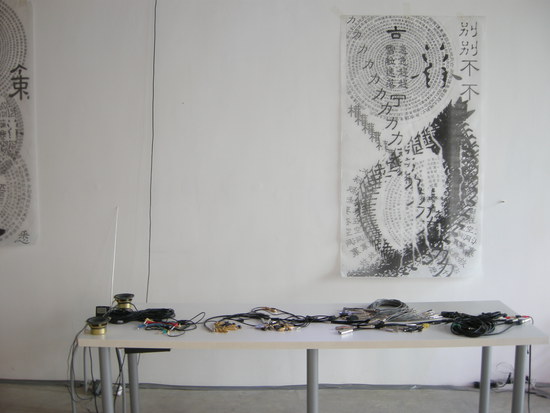
阮千瑞设计的海报在维他命艺术空间(北京)
除了水陆观音,还有撒把芥末系列演出海报,先是ASTRO来北京,我顺手用了我接活用的工程图纸,直接扫进去,用打印机打出来,找了一只昆虫放上去,当时一看到这种错落的线条横亘在那里,真的感觉特别漂亮,是很美的感觉。
然后08年末到09年初又做了焚琴煮鹤系列演出的设计。
之前Mini midi的时候我们还尝试用了印章,印章就是最小的印刷机。
大友良英来北京那一次,我做了完全独立,但又相互联系的三张海报,运用到了很多奇怪的想法,比如放到电视机上去拍,可以得到那些细小的网点,然后再叠加再印,电视机的感觉就出来了,很虚幻。
2010年的“撒丽不跳舞”先锋音乐节,是更加放开,更加疯狂的创意,全部是文字,完全是声音诗的一个剪贴版,而且我想可以把海报作为一个道具放到现场中去,作为演出的一部分,数张大幅的,旋转着的文字阵,全部悬挂在场地中,不是海报,更像是地图,意念里的地图,完全是和声音发生关系,极具宗教感,当时算是我跟王凡,车前子三个人的一个作品。
尤伦斯系列演出,是以一个资本家的姿态来做事情的,撒把芥末是无产阶级,是一群穷光蛋。我们本来就不需要讨好任何人,就做我们自己想做的就好了。我们跟他们有一种类似租赁的关系,他们是房东,我们是房客。当时摆在我眼前的就两样东西,图形和照片,我在想怎么让一切变的更简单。第一期做出来之后,颜峻觉得很好,他说它表达出了一种冒犯,人们从里面看不到任何的信息,只是一种质感,我们只是告诉你我们来了而已,只是一种掷地有声的存在感。随之第二次,第三次,就变得越来越简单了。
旁边儿: 你能简单说一下你个人的创作受过哪些国外设计师的影响?
阮: 我记得当我看到Joy Division的唱片封套的时候,我就感到很震撼,原来这也是一张唱片。那个时候五道口的打口碟,不仅仅是唱片,是音乐而已,它带来的是一种对当时年轻人固有美学的冲击,艺术家除了需要敏锐的感知力,我觉得更重要的是你有一套你自己创作的方式。
我意识到当代艺术家们现在做一些作品的理念是旧的,很早以前,那个科技匮乏的时代,人们早就开始想一些奇怪的事情,尤伦斯的灯箱正好派上了用场,我们放了重复的几张,可以让人们更直观地看到图形演变的过程。它是不是作为一张海报这件事从始至终都不重要,我只是把我的一个做法放在那里,让人们看到。
旁边儿: 可不可以跟我们聊一聊你对Sub Jam合作这么多年的体会?
阮: 撒把芥末从来都不是一个很正式的东西,它其实是很松散的,你相信自己有能力,有兴趣就加入,不能就离开,很简单,也正因为松散,它才充满可能性,充满生机。它有一种异托邦的氛围,就是说我们偶然相遇,开始一个旅途,而不是永远都抱在一起打造梦幻天堂,旅途里会发生各种各样的变故,分分合合,一切都很自由,它跟政治无关,对我来说,它更是一种默契。
只能说在合作的过程中,我们相互渗透的一种感觉。我们也在学习,学习如何生存。
旁边儿: 今年一月末你要开始在伦敦一个月的旅行访问,有没有在国外做个人展览的想法?
阮: 还是体验和感受为主,不想考虑太多,后来我发现这个时代真的是充满各种机会,所以在兴奋的同时要更加小心,不一定对机会都是带着善意和开放,它对你的障碍在于,你会越来越没有勇气去干掉自己,而是在维护,如果要做坏事,还是少让人知道你比较好。
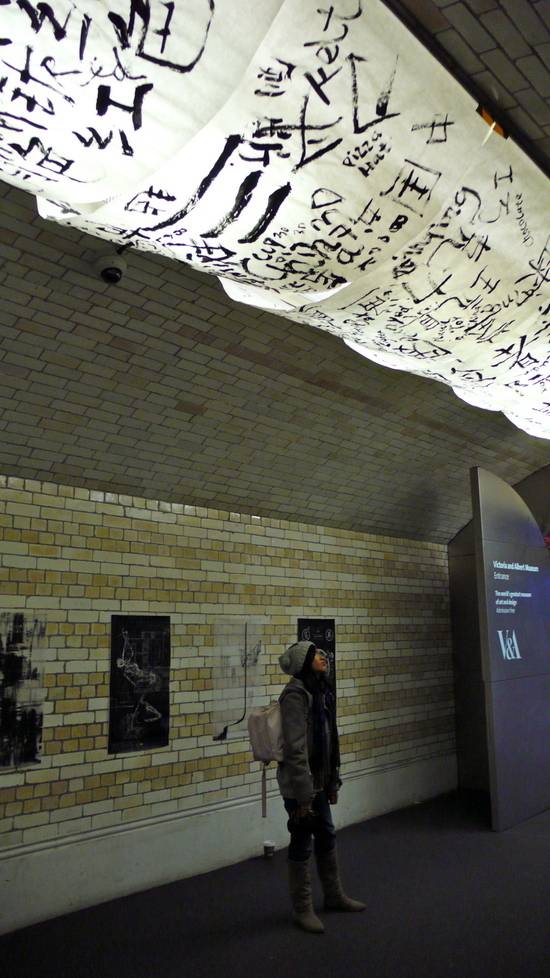

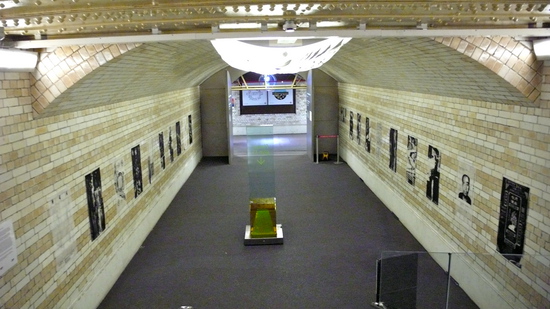

结束伦敦之行之后,阮千瑞再次接受访问:
旁边儿: 在伦敦有什么新的机会?下一步会不会去其他国家做个人展览?
阮: 没有机会,只是碰到一些人,大部分在途中碰到的人似乎跟我一样,没有方向,被房租和房子折腾,被恋爱和爱人折腾。只要你是中国人,别人都会对你感兴趣,但很有可能是对你的屁股感兴趣。
旁边儿: 你最近给FM三的成员张荐做了一张“名片” —— 用一枚硬币,一面是张荐的侧脸,另一面是唱佛机的喇叭,还有一些小的设计在上面。你是怎么想到这个创意的?
阮: 聊了很久,也做了很久,一年前就应该做出来的一个想法。动机很简单,就是钱和音乐,开个玩笑。后续基本上是磨合出来的,看起来是个小东西,不过制作过程比想像的要麻烦很多。张荐是音乐人里最好的设计师,这期间我学到很多。
旁边儿: 未来的计划是什么?和撒把芥末新的合作是什么?还有未来你想和哪些艺术家和音乐人更多的合作?
阮: 可以确定的是我会做的更少,也不想有什么合作,近一年来也没有什么追求,把自己和欲望控制好即可。撒把芥末半年内大概也不会做什么,库存的唱片和朋友一样多,卖唱片卖书然后多自己呆着,我想这是休息的好时候。
After featuring Subjam designer Ruan Qianrui’s album design, I was eager to learn more about his history and process. Over the last 5 years, he has almost single-handedly articulated the visual culture of Beijing’s experimental music scene. 2011 has already been a big year for Ruan: in January he went to London for an exhibition of his design work at the Victoria & Albert Museum. Now back in Beijing, he’s ready to release “Burned Blueprint”, a Subjam-published retrospective of his design work from 2006-2010.
I talked with Ruan about his history as a graphic designer, his experiences in the Subjam/Kwanyin orbit over the last 5+ years, and his incipient career as an international artist. Read on to learn more about all this and see some samples pages from “Burned Blueprint” (which will be available for purchase in the pangbianr distro – more info soon!).
(The interview was conducted in Chinese by Josh Feola and transcribed and translated by Lulu Chow.)
pangbianr: When did you come to Beijing?
Ruan: 2001. The main reason I came is that this city is much closer to art. My collaboration with Yan Jun started in 2006 with Waterland Kwanyin.
pbr: Do you have any formal graphic design training? Art school or technical courses?
Ruan Qianrui: No, never. Since I moved to Beijing I’ve had some jobs doing advertising design, but the experience was more like a process of borrowing and learning techniques. I think I was lucky to meet certain people who were glad to pass on to me some of the finer details of the process.
pbr: How did you first get involved with Subjam/Yan Jun? How did your collaboration with Subjam evolve over time?
Ruan: I had seen some earlier rock shows at Wudaokou at a club called Happiness Palace. They had a series of shows called “ Direct Hit”, that was amazing! At that time, you could feel a lot of anarchist sentiments in the performances, the impact of western social movements during the 80s. A lot of vigorous voices said, “Young people can change the world,” and I began to think that I have strong feelings about these things. By 2006, I had been doing commercial graphic design for a long time and had a lot of experience. At this time I was skillful enough to go out on my own and spend time on what I was really interested in. Waterland Kwanyin started at exactly the same time. I always checked the website, I was really interested in it, so I kept following it.
I started working through Sub Jam’s platform, making posters for these shows. After 2 years, I realized that I could get to know a lot of people I wouldn’t normally get the chance to meet, a lot of weird, strange musicians. We had a lot of things in common and we had a platform to share our feelings.
In 2007 I moved to Changsha for a job, but I didn’t stop doing these designs for Sub Jam. One day in Changsha, in 2008, I finally decided that I couldn’t continue to do commercial advertising. It’s fucking boring. I don’t want to be a money machine. Of course I can get a lot of money from this job, but from the bottom of my heart I can’t accept it. I felt unhappy, rich but regular and mechanical. A life of repetition means nothing to me.
So I quit my full-time commercial design job, went back to Beijing and picked up some part-time freelance graphic design jobs. I thought, “It’s time to start to do my own things. Through making the posters and record cover art for Sub Jam, I can focus on my new attempt at art.” The progress is definitely variable, but the most important thing is not whether I do it well or not. I don’t care about the result, I just want to try different methods, I want to experiment with different media. This way I can keep my mind fresh every day. This is exactly the creative condition that artists usually seek. I just want to fall into this condition.
At the Mini MIDI Festival in 2008, I met more musicians. It was really fun. Suddenly I felt this is exactly what I want.
pbr: Can you talk about your art and your creative process?
Ruan: My train of thought is very fluid. The posters are for a one-time performance. We don’t have many resources to use for making the poster, mostly people helping us as friends and fans. We wanted to make something really amazing and cheap. We focused on a hand-made process. To us, this felt similar to designs from the handcraft workshop at the Bauhaus: work that could shock and convey an industrial power.
Because we only made one or two copies of the posters for each show, I wanted to make them bigger. On one hand, the function of the poster is just to hang there during the show, act as an introduction, create an atmosphere, and also to be uploaded as a small picture for online promotion. That’s it, very simple. But I also wanted each poster to have its own value beyond the shows, my own work. So later in 2008 I just designed posters according to my own feeling, not necessarily related to the shows. I put myself into it, not thinking about design. This thought continued until 2009. I realized this is the way I want to work.
There was a really big discovery: One day, on a run to the print shop, I found that beside the regular printer they also have a large format printer used for architectural plans. You could print on transparent tracing paper, A1 size, for just 5 or 6 yuan, and the colors were just black and grey.
In the Three Guitars performance series , some classic ideas gave me a lot of inspiration. Very concentrated, yet very relaxed and strong. On one side you can feel the empty yard as far as the eye can see; on the other side you can sense pressure ready to explode; these forces co-exist. When I printed it, I was completely shocked. I was punched by this, how it looked — extremely calm, full of power, and so cheap to produce. So after that, I made all Waterland Kwanyin posters this way.
The black and white, the cool lines, transparent objects… when the light hits it, they are all alive, the atmosphere they create covers everything.
I kept trying different graphic styles. I employed some very modern and industrial effects, but also some elements of classical Chinese style. This method of design and printing is very casual because experimental music and the people around it are casual. Sometimes I tried to abandon the patterns and picture collage and just leave some Chinese characters. I tried to interpret the feeling of sound, the cadence of the score.
pbr: Speaking of these Eastern cultural elements, have you been affected by Buddhism, Chinese painting, or the visual culture of Daoism?
Ruan: At that time I didn’t think about that much. I just made designs that I liked. I tried to make work that was really powerful and full of tension.
Back to the creation of the Waterland Kwanyin posters: I thought, “I might be more extreme.” Based on my understanding of noise music, I decided to abandon the patterns and stopped correcting my pictures. I started to make some images of noise. I designed some Chinese characters using untraditional, very non-professional methods: burning, sticking, using some wrong characters, etc. I used digital effects to apply a heavy and old feeling: rubbed trash on the image, overlaid engineering blueprints, scanned the whole thing and then selected parts of the resulting image. At that moment, you find the rubbish is the most beautiful thing.
I still keep thinking of the visual language of sound. When I try my best to hear the sound, the sound’s shape will emerge in my brainwave. The style of the posters for the later period of Waterland Kwanyin is like this. One piece of tracing paper, separated in half. One side is the image, one side are the words. You can hold the balance there. The wrong image, corroded negative film, etc, sometimes they are similar to the way these artists are making music.

Ruan Qianrui poster displayed at “The Shop” (Vitamin Creative Space), Beijing
Besides Waterland Kwanyin, I also made posters for other Sub Jam concerts. First, when Astro from CCCC came to Beijing from Japan, I used engineering blueprints from my part-time job, scanned them, printed them, then put a bug on it. At that moment, I saw the interlaced lines laying down there, really fucking beautiful, what a beauty.
Then from the end of 2008 to the start of 2009, I designed posters for the Fen Qin Zhu He (“Destroy all beauty”) concert series.
Before that, at the Mini MIDI festival, we also used a seal. A seal is the smallest printer.
When Otomo Yoshihide came, I made 3 posters which were completely separated, but also connected. I got a lot of weird ideas: I took photos of my TV because I liked the tiny dots, then overprinted again. The final result conveyed the real feeling of TV, so phantom-like.
By the time of the “Sally Can’t Dance” music festival in 2010, my ideas became even more open and crazy. I only used words in the design, like a clipboard of a sound poem, and I thought I could use the poster as a prop, part of the performance. So I made several big pieces with rolling character waves, which were hung during the show. They were not posters, but more like maps relating to the sound. They had a religious feeling. This was a collaboration between Wang Fan, Che Qianzi and I.
The UCCA concerts [UCCA/Subjam 2010 performance series] were held in a very capitalist context, but Sub Jam is totally proletariat, we are a bunch of paupers. We don’t need to kiss up to anybody, we just do our own business, that’s all. We had a kind of leasing relationship with them: they are the landlord, we are the tenants. At that time, there were only two things in front of my eyes: basic patterns and photos. I wanted everything to be simpler. When the first poster for this series came out, Yan Jun said it was great. He said it expressed a kind of offensiveness. People can’t find any information on it, it was just a tactile sensation. We just told you we are here now, and this strong existential feeling punched you in the face. And after this, the second time, the third time, it became much easier.
pbr: The poster for one of the UCCA/Subjam shows [above] strikes me as especially “Modern”. It reminds me of Marcel Duchamp’s Trois stoppages étalon.
Ruan: Well you know, I realized that the ideas of some contemporary artists are very old. A long time ago, without modern technology, artists started to think in some really strange ways. When I arrived at UCCA, the lightboxes there were fantastic. I put several copies of my posters on them, and people could see the progress of change. It was not important that the poster was used as a poster, I just put my idea there and let people know.
pbr: What foreign artists have influenced your work?
Ruan: I remember when I saw the record cover of “Unknown Pleasures” by Joy Division, I was shocked. I thought, “Wow, this can be a record cover?!” A long time ago the Dakou disks you could buy in Wudaokou were not just musical revelations: they brought a shock to young people’s aesthetic senses at that time. In addition to a keen perception of aesthetics, however, an artist also must have a strong personal sense of style.
pbr: Over time, as you have come to single-handedly design the visual culture of Waterland Kwanyin/Subjam, do you feel you have a more formal “role” within the label?
Ruan: Sub Jam was never a formal thing, it is very casual. You should believe that you have the power and ability and the interest in these events, then you can join, or you can leave. It’s easy. Because of this casual way, it can bring together a lot of possibilities and energy. It is a heterotopia, it’s like we met each other by chance and started a journey. It’s not like we hang out all the time and promise each other to build an idyllic paradise… there will be a lot of changes along the journey, unions and departures. Everything is free and casual. It has nothing to do with the politics of human relationships. For me it’s just like an agreement and understanding.
I can only say that during the time we work together, we share honest feelings. We are learning, learning how to survive.
pbr: Your work was exhibited in the V&A museum in London this January. How does this exhibit fit into your development as an artist?
Ruan: I think the most important thing is the experience. I don’t want to think too much about it. Too many opportunities are arising now, so I must be very careful. Not all of the opportunities are kind and open. The problem with having all of these opportunities is maybe you have less and less courage to criticize yourself, to beat up on yourself. You are more inclined to protect yourself. If you want the freedom to destroy, it’s better if fewer people know who you are.




Ruan Qianrui at the V&A Museum, London (photos by Liang Kun)
pbr: What was your experience in London? Does this make you want to exhibit more internationally?
Ruan: There’s not much I can say… it was an opportunity. I met some people along the way, most of them just like me, no direction, tortured by rent, harmed by relationships and lovers. If you are Chinese, everybody will be interested in you, or maybe just interested in your ass.
pbr: You recently made a “business card” for Zhang Jian from FM3, which is actually a coin with Zhang’s face and some slogans in different languages. Can you talk more about the concept behind this design?
Ruan: We talked a lot before and I thought about it a lot, we had the idea nearly one year ago. The motivation is really simple. We want to make a joke about money and music. The physical coin came from this joke. It seems like a small thing, but the process of making it was more difficult than we’d imagined. Zhang Jian is the best designer among all the musicians I’ve met, I learned a lot during this collaboration.
pbr: What are your plans for the future? Do you have more projects for Subjam? Are there other artists or musicians you want to work with?
Ruan: I think I’ll only do a few projects. We haven’t had any collaborations recently. I have no plans lately, I just want to settle down and focus on my own desires. In the next half year, Sub Jam probably won’t do much either. There are as many disks in storage as we have friends. We will try to sell the disks we’ve already made and spend the rest of the time doing our own things, because I think it’s time to relax.
